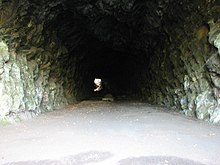 Looking back through the tunnel from the edge of the Lehigh River. Ties from both tracks can be seen, strewn with rockfall from the ceiling. Looking back through the tunnel from the edge of the Lehigh River. Ties from both tracks can be seen, strewn with rockfall from the ceiling. | |
| Overview | |
|---|---|
| Line | Main Line |
| Location | Carbon County, Pennsylvania, USA |
| Coordinates | 40°52′57.9″N 75°45′40.3″W / 40.882750°N 75.761194°W / 40.882750; -75.761194 |
| Status | rails removed; accessible to hikers |
| System | Central Railroad of New Jersey |
| Operation | |
| Opened | 1866 |
| Closed | 1956 |
| Owner | Lehigh Gorge State Park |
| Technical | |
| Track length | 496 feet (151 m) |
| No. of tracks | Double |
| Track gauge | 1,435 mm (4 ft 8+1⁄2 in) |
The Turn Hole Tunnel is an abandoned railroad tunnel near Jim Thorpe, Pennsylvania. Built by the Lehigh Coal and Navigation Company, it carried part of the Lehigh and Susquehanna RR main line until 1912, and was used as part of a passing siding for several decades thereafter. It is now an attraction in Lehigh Gorge State Park.
History

The tunnel takes its name from the "Turn Hole" in the Lehigh River, a deep eddy where the river makes a turn at the base of a high cliff, known as Moyer's Rock. When the Lehigh and Susquehanna Railroad (a subsidiary of the Lehigh Coal and Navigation Company) extended its line from White Haven to Mauch Chunk (now Jim Thorpe) in 1866, it crossed the Lehigh River at the Turn Hole and tunneled 496 feet (151 m) through the face of the cliff, proceeding southward through the gorge. The parallel line of the Lehigh Valley Railroad crossed the river just to the west, but swung around the point of Moyer's Rock instead of tunneling. The Lehigh and Susquehanna was leased to the Central Railroad of New Jersey in 1871.

The tunnel carried two tracks of the CNJ main line until about 1910, when it was condemned. The railroad began contracting to bypass it in 1911, grading a new alignment parallel with the Lehigh Valley. The new alignment was opened in 1912, but the two tracks in the tunnel and over the old bridge were kept intact as a passing siding until 1956, when they were abandoned.
The CNJ main line through Lehigh Gorge was abandoned in late 1965. While most of it has become the Lehigh Gorge Trail, the new alignment around Turn Hole Tunnel was paved as an access road to the Glen Onoko trail head of Lehigh Gorge State Park. The tunnel remains largely intact, with ties from the double track remaining in situ, occasionally covered by rockfall. At the north portal, overlooking the river, a safety railing has been built across the tunnel. The piers of the old bridge still stand in the river.
References
- LC&N records, Pennsylvania State Archives MG311
- Gordon, Thomas Francis (1832). A Gazetteer of the State of Pennsylvania. Thomas Belknap. p. 326. Retrieved November 27, 2008.
- Allen, Richard Sanders (1959). Covered Bridges of the Middle Atlantic States. Stephen Greene Press. p. 28. ISBN 9780517128763. Retrieved November 27, 2008.
- ^ Taber, Thomas T., III (1987). Railroads of Pennsylvania Encyclopedia and Atlas. Thomas T. Taber III. p. 308. ISBN 0-9603398-5-X.
{{cite book}}: CS1 maint: multiple names: authors list (link) - Drinker, Henry Sturgis (1893). Tunneling, explosive compounds, and rock drills. John Wiley & Sons. p. 1086. ISBN 9780727752680. Retrieved August 14, 2011.
- "Railway Construction". Railway Age Gazette. 51 (5): 269. August 4, 1911. Retrieved November 27, 2008.
- "CNJ: White Haven to Mauch Chunk". Retrieved November 27, 2008.